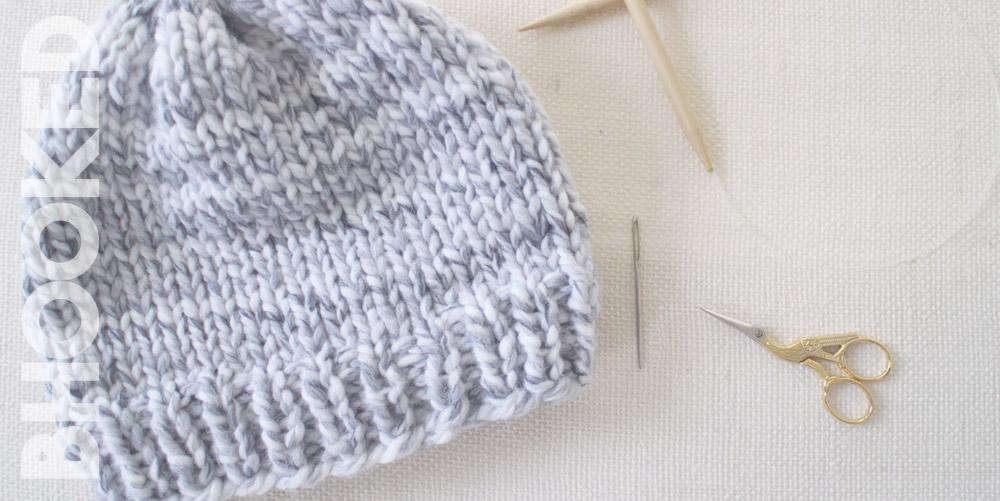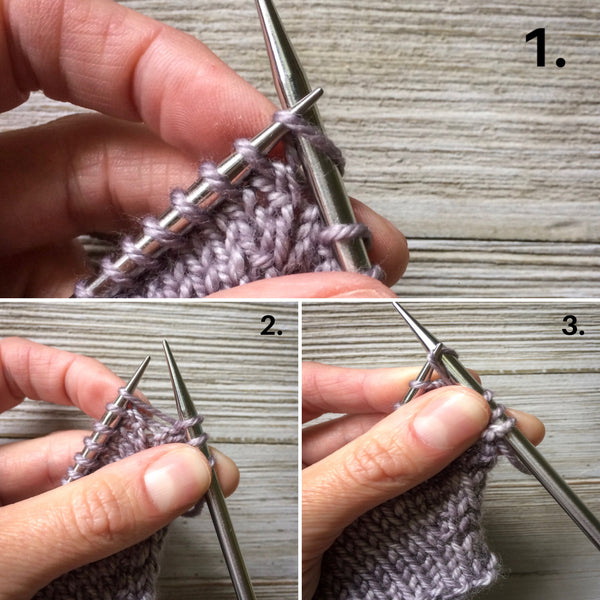
"Make one" can be used to refer to "to make a new stich." Although there are many ways to accomplish this, the pattern will likely specify one. Choose the method that you want to use based on your preferences. Specific techniques may be listed on the pattern to make certain stitches. These techniques may have different special effects and are listed on a pattern for specific purposes.
M1L
M1L is an abbreviation for "make a one left" and it is a leftwardly-leaning stitch. Usually it's used in conjunction with an increase on the left side, but you can also find it on its own in a pattern. M1R is almost identical. It's done by holding two knitting needles in close proximity so that there is a ladder between the stitches.

M1R
The M1R is an increase in knitting that creates a twisted stitch. It is most often used in an opposite direction to M1L and is located between stitches from the previous rows. Its purpose is to increase the stitch without creating a gap.
Knit front back
Knit front-and-back is a great technique to improve your knitting skills. This is a basic stitch that you should know to increase a project.
KFB
M1 stands for "Make One". This stitch looks very similar to the yarn above, but it increases how many stitches you have. The main difference between kfb and M1 is that the former increases stitch count by using one stitch. The latter increases stitch count between two existing stitches.
Purling in the front and back not as intuitive as knitting in the front and back
A common technique in knitting patterns is to use pfb (purling in front and back). This stitch is easy to learn, especially if your knitting skills are good. This technique increases the number of stitches per row.

Making pattern following easier
For beginners, pattern reading can seem overwhelming. But if you can follow a pattern without looking at each step individually, you'll be able to make more projects and save money on yarn. Here are some tips to help you make pattern following more enjoyable.
FAQ
Which hobbies are most in demand right now?
Popularity is not always a good thing. It is often used as an excuse for mediocrity. Many people have no time for hobbies or other interests. They are too busy trying to make ends meet. So what should you do if you don't have much free time? You could start your own company.
However, this isn't easy. There are many obstacles to overcome before you can turn your idea into reality.
If you are looking for something more than running a business you might consider starting a hobby.
Hobbies don't have to be creative. There are many different kinds of hobbies available. These include:
-
Gardening
-
Cooking
-
Photography
-
Reading
What are your top hobbies?
Your favorite hobbies are ones you enjoy. It will be easier to continue doing what you love if you are passionate about your work. It will also be easier to find a reason to stop feeling tired or sick.
The hobbies we all love are gardening, painting and crafting, photography.
Another option is to volunteer at a local charity shop.
Let's say you are looking for something more exciting. Take up skydiving or rock climbing, parasailing, parasailing and paragliding.
There are many other ways to spend time outside. These include caving and cave tubing.
What are educational hobbies?
An educational hobby is a activity that allows you to learn by doing it. This could be anything you want, such as playing sports or learning how to play an instruments.
It should be enjoyable and fun for you. It doesn't have to be done all the time. However, if you get bored of it, you should think about other things you can do instead.
These activities can also be costly so make sure you don't spend too much.
What is a hobby that kids can do?
Hobby for children is anything they enjoy doing outside of work. Some kids like to build things, draw, paint, write, or play with toys.
Many parents worry that their children will get into trouble if they're allowed to do whatever they want. This is not necessarily true. If your child is safe and doesn't cause harm to themselves or anyone else, they won't get into trouble.
It's important to remember that just because they like to do something doesn't mean that they'll always choose to do it. For example, if they love drawing pictures but they hate writing, then they may decide to draw pictures instead of writing.
There are lots of different types of hobbies out there, so it's really up to you to pick one that you enjoy most.
Can I make money by my hobby?
Many hobbies can bring in extra income.
If your hobby is a passion, you may be able to sell related items.
If you're a collector of stamps, you may be interested in establishing a website to sell them.
This allows you to make additional income, without having the hassle of actually purchasing and selling stamps.
You could also create a YouTube channel to talk about your hobby.
This allows you share your passion and generate revenue by creating premium content.
What are the competitive hobbies?
Competitive sports include running, swimming, cycling, golfing, tennis, etc.
They're a great way to get social interaction and are enjoyed by those who love physical activity.
If your hobby is physical activity, chances are that others share it.
This could be as simple as joining a sports club where you play regularly together.
You might also choose to participate in team games involving playing alongside others.
These include soccer (soccer), rugby, netball and hockey.
There are many types of competition.
Some competitions exist solely for recreational purposes.
Others are meant to test competitors' skills.
Others are also designed to reward exceptional performance.
In these cases, the winners receive prizes.
Other competitions test strength and endurance.
These are called endurance events.
For example, marathon races, triathlons, Ironman Triathlon, etc.
Athletes often train hard before competing in these events.
They will adhere to a strict training program that prepares them mentally as well as physically.
They might need to travel some distance during preparation.
It's important to remember that not all athletes compete in every type of event.
What are some enjoyable hobbies for seniors
Senior citizens should find activities they love to do. Senior citizens should keep active through participation in physical and sports activities.
They may be interested in joining clubs to find people with similar interests. As they age, this will help them feel less alone.
Seniors must also be on the cutting edge of new trends. You could, for example, follow the latest trends in fashion, literature, and music.
Statistics
- In comparison, men in the “no humor” condition were refused 84.6% of the time and were only accepted 15.4% of the time. (time.com)
- Much of this decline reflects the fact that teens are less likely to work today than in the past; among employed teens, the amount of time spent working is not much different now than it was around 2005. (pewresearch.org)
- Almost 80% of people claim to have no hobby. (hobbylark.com)
- A new survey by Pew Research Center of teens ages 13 to 17 finds that 36% of girls feel tense or nervous about their day every day; 23% of boys say the same. (pewresearch.org)
- This 100% accurate personality-analyzing hobby quiz discovers your passion based on your characteristics. (quizexpo.com)
External Links
How To
How to get started gardening
Gardening is one the oldest forms. It requires persistence, patience, and determination. The first step to starting a garden is to pick a spot where you will grow food. You can choose to have a large area or a small one in your backyard. Next, pick the type of plants that you would like. Do you prefer flowers or vegetables? Some people love to grow herbs, while others enjoy raising animals like rabbits. Before you decide on the type of crops you want to plant, it is important to consider the space available. If you live in a climate that experiences cold winters, then you might decide to grow fruits or berries as they do well in colder climates.
Once you have chosen what you will be planting, you must take some time to prepare your soil. Your plants' success or failure will depend on the soil they are placed in. High quality soil is rich in organic matter, which feeds your plants' roots. Organic matter includes organic matter such as leaves, twigs or grass clippings. After you have prepared the soil, you will need to add nutrients. You will need different amounts of nutrients depending on which type of plants are being grown. You can calculate these values online with a fertilizer calculator. Many fertilizers are on offer, so make sure that you know which one you are buying.
After preparing your soil and adding the proper nutrients, you now need to wait until your seeds germinate. The process takes between 2 weeks and 3 months depending upon the climate in your area. Once your seeds are sprouted, you must water them regularly. Too much or too little water can cause problems. Overwatering can cause problems. Overwatering can lead to root rot and fungal diseases. Keep in mind that plants are more thirsty during summer than winter. Also, remember that certain plants need to dry out after watered. For example, tomatoes need to stay slightly moist but not wet. They won't tolerate soggy soil. After the flowers have stopped, they must go into dormancy. Dormancy is when plants stop producing new growth and begin storing energy for the next season's harvest. The plant ceases sending signals to its roots to produce food during dormancy. Throughout this time, plants can store energy. However, if the temperatures drop below freezing and there isn't enough sunlight, the plant will go to sleep.
Urban areas can limit your choices for plants. Concrete sidewalks, roads or parking lots can block sunlight from reaching urban areas. Concrete absorbs light and prevents soil below from getting sufficient sun exposure. This is why many plants cannot thrive in cities. There are many plants that can survive in urban environments. Many trees, shrubs and perennials can thrive in urban environments. In addition, many annuals can be grown indoors in containers. You can have fresh greenery all year round with container gardens.
You're now ready to plant after you have chosen where and what to grow in your garden.